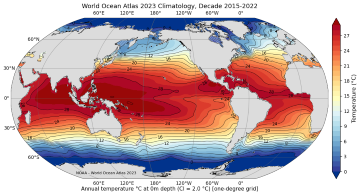760725_Ocean Memories_360 px width.png

Average global sea surface temperatures. The "memory" of the ocean is retained in the surface mixed layer. Credit: NOAA - World Ocean Atlas 2023
The oceans are losing their memory. That could make it harder to forecast everything from monsoons to blizzards.
Ocean “memory” is maintained in the top layer, called the mixed layer. Winds push warm surface water downward, where it mixes with water at greater depths. This layer is typically about 150 feet thick. And overall, it maintains a fairly constant temperature. When the temperature changes as the result of some major event, it can take 10 to 20 years for the change to dissipate. In other words, the ocean maintains the “memory” of what happened to it for that long.
As the air warms up, though, ocean memory may be changing. Researchers recently simulated changing ocean conditions with computer models. Their work suggested the memory span may be getting shorter, mainly because water at the surface is getting warmer and less dense, so it doesn’t sink as easily. As a result, the mixed layer gets thinner, so its temperature can change more quickly. The quicker the change, the shorter the memory. As one researcher described it, the ocean develops amnesia.
Ocean memory is an important factor in forecasting conditions in both the oceans and the atmosphere. Scientists use it to predict monsoon seasons, heatwaves, exceptionally wet summers and cold winters, and other major climate events. A shorter ocean memory could cut months from the lead time of these forecasts—making it harder to remember whether to take an umbrella or sunscreen on your next outing.

